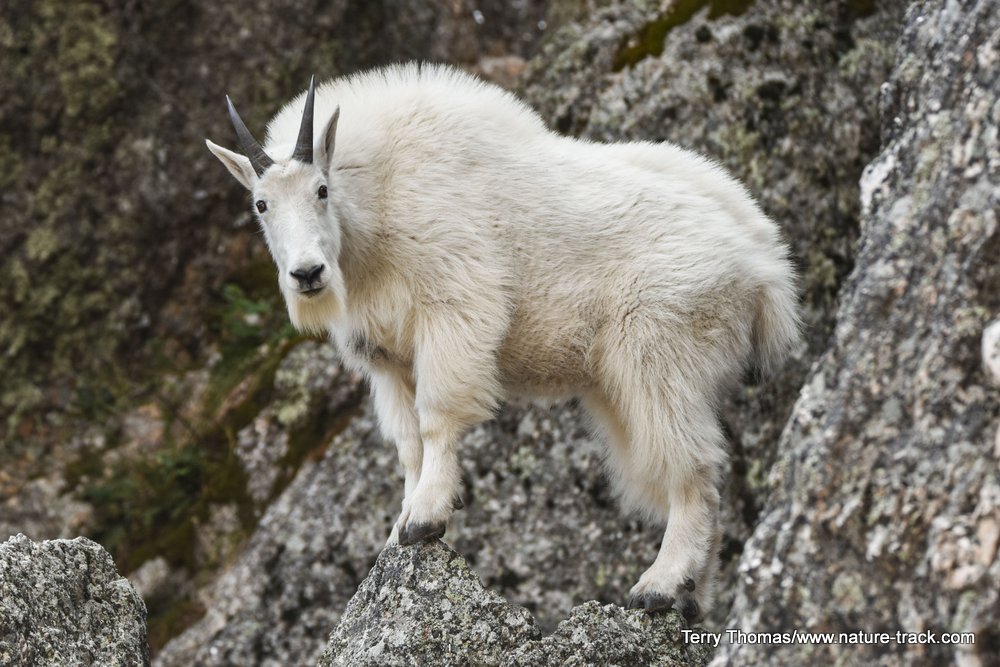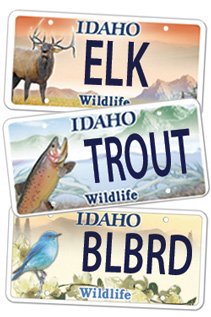Mountain Goat and Grand Teton National Park

Mountain goats. We all love them but sometimes transplanting them into new habitats comes back to bite us.
When I first heard of Grand Teton’s “final solution” to the mountain goat issue, I have to admit, my knee-jerk reaction was probably similar to many people in the area. Really? They are going to eliminate mountain goats in order to protect bighorn sheep? That seems a little extreme. Like everyone else, I LOVE to see the mountain goats just east of Alpine, Wyoming.
Here’s a quick review of the issues. The bighorn sheep in Grand Teton are one of four herds in Wyoming considered coordinative herds. This herd is a small isolated native herd that has never been supplemented or extirpated and re-established. It is in decline (down to 80 animals from an estimated 125 animals just a few years ago) and may not withstand additional stresses.
The mountain goats are threatening the herd in two ways. First, they are competing for forage in extremely limited winter range habitat high on isolated windswept ridges. Second, and likely more important in the short term, mountain goats in the Palisades Range (the source of the mountain goats in the Park) have all five of the pathogens known to be extremely lethal to bighorn sheep. The Wyoming Wild Sheep Foundation states that two of these diseases are already in the Park.
The final argument for removing the goats is that the best science and historical records indicate that the mountain goat is not native to the greater Yellowstone ecosystem. In the case of the Teton herd, its progenitors were introduced by Idaho Department of Fish and Game in the Palisades Range south of the park over 50 years ago. They expanded eastward into Wyoming and then north into the Park. Mountain goats are native to North America, but in the Teton Range they are exotics, unnatural competitors with the sheep.
So, it comes down to a choice between the two species. It isn’t going to end well for one of them. Should we protect the native sheep and remove the goats or let the goats eventually replace the sheep? We can’t have it both ways.
Are there other alternatives? Sure. The Park could allow hunters to do the job. After all, there has been a limited elk hunt on a small portion of the Park for years. However, this could, quite literally, require an act of Congress.
How about trapping and transplanting? There is precedent for that. Olympic National Park is in the third year of removing 700 plus non-native mountain goats (transplanted to the Olympic Range in the 1920s for sport harvest) from the park to stop habitat damage to fragile alpine ecosystems that evolved without grazing pressure from bighorn sheep or mountain goats. The first two years have resulted in the removal of about 330 goats at a cost of about $2,700 per goat, or about $900,000. Those that remain after this coming season will likely be shot. And this wasn’t the first time for Olympic National Park. They removed 400 mountain goats in the 1980’s, but apparently didn’t get them all. Some people in Washington State question whether it is appropriate to spend this many taxpayer dollars on a species sometimes referred to as invasive. Seems that the parks can’t win this game. No matter what they do, there will be vehemently vocal critics.
Despite my original misgivings, the Park Service plan seems to be fiscally and biologically responsible. To do nothing is the same as to say that the exotic mountain goat will eventually destroy this herd of bighorn sheep and that just isn’t acceptable to me. So, with a tear in my eye for the goats, I give the thumbs up to the sheep.
NOTE: after this column ran in the Post Register, I had a reader write wondering why mountain goats and bighorn sheep can co-exist in Glacier National Park where they are both native, and not in Grand Teton National Park where the bighorns are native and the mountain goats are not. There are two reasons.
First, bighorn sheep and mountain goats in GTNP are competing for the same, relatively small, piece of winter range. Mountain goats are more aggressive and will win that battle eventually. In areas where they are both native, this issue was sorted out eons ago and competition is likely relatively minor.
Second, is disease. The mountain goats in GTNP may have all five of the known viruses known to be highly lethal (like nearly 100%) to bighorn sheep. Domestic sheep ranching on public land in the Palisades Range to the south is big business with thousands of sheep grazing there each summer, often right next to mountain goats. Because of this, the Palisades Range will never be suitable bighorn habitat. In addition, the mountain goats are likely picking up the disease vectors, which don’t really affect them, and transporting them to the bighorn sheep in GTNP. This isn’t happening in Glacier NP.
Help Idaho Wildlife
When we traveled across the state in October 2017, we visited most of the Idaho Department of Fish and Game wildlife management areas. Most of the vehicles we saw using the wildlife management areas did not have wildlife plates. Buying wildlife plates is a great way for non-hunters and hunters alike to support wildlife-based recreation like birding.
C'mon folks, let's help Idaho's wildlife by proudly buying and displaying a wildlife license plate on each of our vehicles!
See below for information on Idaho plates. Most states have wildlife plates so if you live outside Idaho, check with your state's wildlife department or vehicle licensing division for availability of state wildlife plates where you live.
And tell them that you heard about it from Nature-track.com!

Wildlife License Plates
Great news! as of 2024, there are three NEW designs for license plates. They still are bluebird, cutthroat trout and elk, but they are beautiful.
Idaho Wildlife license plates provide essential funding that benefits the great diversity of native plants and wildlife that are not hunted, fished or trapped—over 10,000 species or 98% of Idaho’s species diversity. Game species that share the same habitats (such as elk, deer, antelope, sage-grouse, salmon, trout) also benefit from these specialty plates.
No state tax dollars are provided for wildlife diversity, conservation education and recreation programs. Neither are any revenues from the sale of hunting or fishing licenses spent on nongame species. Instead, these species depend on direct donations, federal grants, fundraising initiatives—and the Idaho Wildlife license plates.
Both my vehicles have Bluebird Plates. I prefer the bluebird because the nongame program gets 70 percent of the money from bluebird plates, but only 60 percent of the money from elk and trout plates - 10 percent of the money from elk plates supports wildlife disease monitoring and testing programs (to benefit the livestock industry) and 10 percent from cutthroat plates supports non-motorized boat access.
Incidentally, in 2014, the Idaho Legislature denied the Department of Fish and Game the ability to add new plates or even to change the name of the elk and cutthroat plates (very specific) to wildlife and fish plates, a move that would have allowed for changing images occasionally and generating more revenue. It would seem that they believe that we Idahoans don't want a well funded wildlife program.
I think it is time we let the Legislature know that Idahoan support wildlife funding and that we would like to see these generic plates come to fruition.

"WOW. What a phenomenal piece you wrote. You are amazing." Jennifer Jackson
That is embarrassing, but actually a fairly typical response to my nature essays. Since The Best of Nature is created from the very best of 16 years of these nature essays published weekly in the Idaho Falls Post Register (online readership 70,000), it is a fine read. It covers a wide variety of topics including humorous glimpses of nature, philosophy, natural history, and conservation. Readers praise the style, breadth of subject matter and my ability to communicate complex and emotional topics in a relaxed and understandable manner.
Everyone can find something to love in this book. From teenagers to octogenarians, from the coffee shop to the school room, these nature essays are widely read and enjoyed.
Some of the essays here are my personal favorites, others seemed to strike a chord with readers. Most have an important message or lesson that will resonate with you. They are written with a goal to simultaneously entertain and educate about the wonderful workings of nature. Some will make you laugh out loud and others will bring a tear to the eye and warm your heart.
Readers Write:
"You hit a home run with your article on, Big Questions in Nature. It should be required reading for everyone who has lost touch with nature...great job!" Joe Chapman
"We enjoyed your column, Bloom Where Planted. Some of the best writing yet. The Post Register is fortunate to have your weekly columns." Lou Griffin.
To read more and to order a copy, click here or get the Kindle version
Copies are also available at:
Post Register
Island Park Builders Supply (upstairs)
Barnes and Noble in Idaho Falls
Harriman State Park, Island Park
Museum of Idaho
Valley Books, Jackson Wyoming
Avocet Corner Bookstore, Bear River National Wildlife Refuge, Brigham City, Utah
Craters of the Moon National Monument Bookstore, Arco, Idaho
Wildlife License Plates
Great news! as of 2024, there are three NEW designs for license plates. They still are bluebird, cutthroat trout and elk, but they are beautiful.
Idaho Wildlife license plates provide essential funding that benefits the great diversity of native plants and wildlife that are not hunted, fished or trapped—over 10,000 species or 98% of Idaho’s species diversity. Game species that share the same habitats (such as elk, deer, antelope, sage-grouse, salmon, trout) also benefit from these specialty plates.
No state tax dollars are provided for wildlife diversity, conservation education and recreation programs. Neither are any revenues from the sale of hunting or fishing licenses spent on nongame species. Instead, these species depend on direct donations, federal grants, fundraising initiatives—and the Idaho Wildlife license plates.
Both my vehicles have Bluebird Plates. I prefer the bluebird because the nongame program gets 70 percent of the money from bluebird plates, but only 60 percent of the money from elk and trout plates - 10 percent of the money from elk plates supports wildlife disease monitoring and testing programs (to benefit the livestock industry) and 10 percent from cutthroat plates supports non-motorized boat access.
Incidentally, in 2014, the Idaho Legislature denied the Department of Fish and Game the ability to add new plates or even to change the name of the elk and cutthroat plates (very specific) to wildlife and fish plates, a move that would have allowed for changing images occasionally and generating more revenue. It would seem that they believe that we Idahoans don't want a well funded wildlife program.
I think it is time we let the Legislature know that Idahoan support wildlife funding and that we would like to see these generic plates come to fruition.